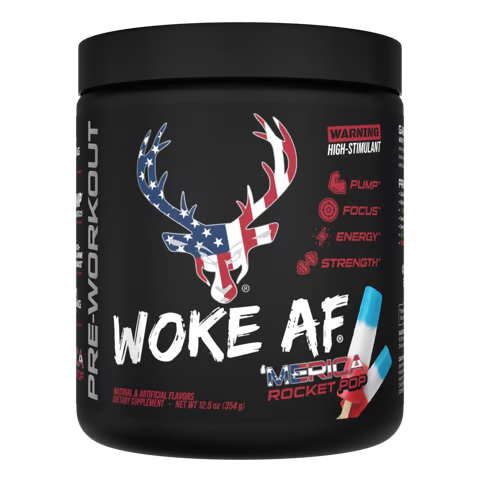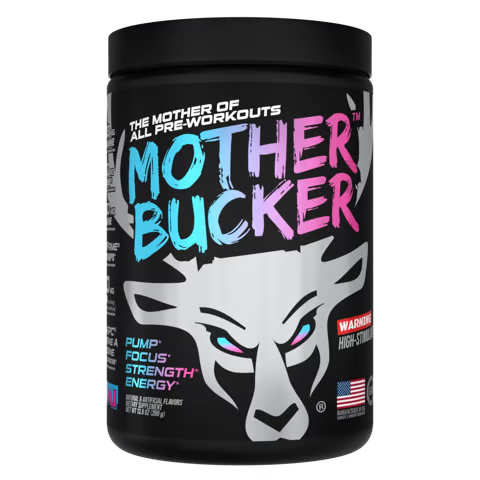Hey there, if you’re looking to get the most out of your workouts, pre-workout supplements and caffeine can be game-changers. It’s not just about whether caffeine works, but figuring out the right amount, timing, and source to power up your training without any downsides.
This guide breaks it down for everyone, from newbies to seasoned gym-goers. We’ll cover how to find your ideal caffeine dose based on your weight, when to take it for maximum effect, and how to pick between options like coffee, energy drinks, or targeted pre-workouts. By the end, you’ll know how to use caffeine for better energy, sharper focus, and stronger performance in every session.
Check out Bucked Up pre-workouts for formulas crafted to support your energy, focus, and endurance with great flavors to match.
Why Caffeine Helps Your Workouts: The Real Benefits
Caffeine is one of the most studied performance aids out there, and it delivers real results for athletes. Taking 3 to 6 mg per kg of body weight can noticeably improve exercise results.
So, how does it work? Caffeine boosts alertness, makes effort feel easier, and helps muscles contract better. You get more stamina, strength, and power during your workouts. You’ll feel these effects in every rep and set.
For cardio, caffeine helps burn fat and save muscle energy, letting you push harder for longer. Endurance activities see some of the biggest gains. In strength training, it ramps up muscle activation, so heavy lifts feel more doable.
Mentally, caffeine sharpens focus and speeds up reaction times. It boosts muscular endurance, speed, strength, and even jumping ability. This means a stronger connection between mind and muscle during intense sessions.
What makes caffeine unique is that it helps both body and mind. It improves attention and keeps performance up even when you’re tired. That’s especially handy for early mornings or post-work training.
How to Find Your Ideal Caffeine Dose for Workouts
Finding the right caffeine dose takes a bit of personalization. It’s based on your body weight and how your body handles stimulants. A good range to aim for is 3 to 6 mg per kg of body weight. Start on the lower side and adjust as needed.
For beginners or those sensitive to caffeine, even less might work. As little as 2 mg per kg can be effective. For someone weighing 150 pounds, that’s about 136 mg, a amount found in many pre-workouts.
To figure out your dose, divide your weight in pounds by 2.2 to get kilograms, then multiply by your chosen mg per kg. A 150-pound person at 3 mg per kg would take around 200 mg of caffeine.
Here’s a quick dosing guide based on weight:
- 130-140 lbs: 120-190 mg (low), 180-255 mg (medium), 240-380 mg (high)
- 150-160 lbs: 135-220 mg (low), 205-290 mg (medium), 270-435 mg (high)
- 170-180 lbs: 155-245 mg (low), 230-325 mg (medium), 310-490 mg (high)
- 190-200 lbs: 175-270 mg (low), 260-365 mg (medium), 345-545 mg (high)
A key point to remember: going over 9 mg per kg doesn’t add extra benefits and can cause issues. Higher doses increase the risk of side effects without improving performance. Very high amounts around 9 mg per kg aren’t necessary for gains.
Everyone reacts differently due to genetics and daily habits. Your personal tolerance plays a big role in how much you need. Start low, test it out over a few workouts, and increase only if you feel it’s necessary.
When to Take Caffeine for the Best Workout Results
Timing your caffeine intake matters just as much as the dose. Taking it about 60 minutes before exercise is often ideal. This gives it time to kick in right when you need it most.
The window can vary a bit depending on the source and your body. A range of 30 to 60 minutes before training is typically effective. The exact time depends on whether it’s a pill, drink, or gum.
Caffeine stays active in your system for a while. With a half-life of 4 to 5 hours, it can keep working through long sessions. This means one dose can often carry you through most workouts.
For very long sessions of 3 to 5 hours, topping up might help. Small doses of about 50 mg or larger ones of 100 mg can maintain the boost. For regular gym time, though, one dose usually does the trick.
Here are timing tips based on your caffeine source:
- Pre-workout supplements: 30 to 45 minutes before for fast absorption.
- Coffee: 45 to 60 minutes before due to slower uptake.
- Energy drinks: 30 to 45 minutes, but watch out for sugar crashes.
If you train in the evening, be cautious. Caffeine too late in the day can mess with your sleep. For late sessions within 6 hours of bedtime, a stimulant-free pre-workout might be a smarter choice.
Comparing Caffeine Sources: Why Pre-Workouts Stand Out
Not every caffeine source works the same for exercise. Coffee, energy drinks, and supplements vary in content and added ingredients. Let’s break down what each offers.
Coffee: Simple and Familiar
Coffee is a go-to for many, with 95 to 200 mg of caffeine in an 8-ounce cup. It can work for lighter workouts, but the amount of caffeine isn’t consistent. This makes it hard to dial in the exact dose you need for steady results.
Another downside is that coffee lacks other performance-boosting compounds. Unlike pre-workouts, it doesn’t support muscle pumps or endurance with extra ingredients. If you’re after all-around gains, coffee alone likely won’t cut it.
Energy Drinks: Quick but Unreliable
Energy drinks offer a fast jolt, packing 80 to 300 mg of caffeine per can. Many are loaded with sugar, though, which can lead to energy drops mid-workout. Some might also upset your stomach during intense efforts.
Most energy drinks hide their exact formulas in proprietary blends. You can’t be sure what you’re getting, which isn’t ideal when you’re aiming for predictable performance from session to session.
Pre-Workout Supplements: Built for Results
Supplements often use a form called caffeine anhydrous for accuracy. This provides a steady, reliable dose compared to coffee. You can pinpoint exactly how much you’re taking.
What sets good pre-workouts apart is the full package. They mix in extras like Beta-Alanine for stamina, L-Citrulline for blood flow, and nootropics for focus. You’re not just getting caffeine, but a blend to lift your entire workout.
Bucked Up pre-workouts, for instance, cover four key areas:
- Energy: exact caffeine doses, sometimes with sustained release.
- Focus: ingredients like AlphaSize and Huperzine A for mental clarity.
- Pump: compounds like Citrulline Malate to enhance blood flow.
- Endurance: Beta-Alanine to help push past fatigue.
Compare that to other options:
|
Feature |
Bucked Up Pre-Workout |
Coffee |
Generic Energy Drink |
|
Caffeine Content |
Precise (200-400 mg) |
Variable (95-200 mg) |
Variable (80-300 mg) |
|
Performance Ingredients |
Full range (Citrulline, Beta-Alanine, AlphaSize) |
None |
Limited (often just sugar, taurine) |
|
Transparency |
Clear labeling |
Not applicable |
Often hidden blends |
|
Performance Focus |
Energy, Focus, Pump, Endurance |
Basic energy |
Short-term boost with crash risk |
Explore Bucked Up options to see how a well-rounded pre-workout can elevate your training.
Choosing the Right Bucked Up Pre-Workout for Your Needs
Bucked Up offers a variety of pre-workouts to match different experience levels and goals. Instead of one generic option, they let you pick a formula that fits where you’re at and scales with your progress.
Bucked Up Pre-Workout: Great for Starters (200 mg Caffeine)
The standard Bucked Up pre-workout has 200 mg of caffeine, ideal for beginners or anyone wanting a moderate boost. This matches the suggested 200 mg for a 150-pound athlete.
It also includes Citrulline Malate for better blood flow, Beta-Alanine for lasting power, and AlphaSize for focus. Taurine aids heart health, Senactiv may improve endurance, Astragin boosts absorption, and Himalayan Rock Salt keeps electrolytes balanced.

Woke AF: Step Up Intensity (333 mg Caffeine)
Woke AF is for those ready for more, with 333 mg of caffeine suited for people used to stimulants. It’s built for harder workouts and better mind-to-muscle connection.
On top of the core ingredients from Bucked Up, it adds Dendrobium for extra energy and Synephrine HCI for stimulation. You still get the pump and endurance support, just with a stronger kick.

Mother Bucker: Max Out Performance (400 mg Caffeine, Dual-Release)
Mother Bucker targets advanced users with 400 mg of caffeine, split into 300 mg instant and 100 mg delayed release for ongoing energy. It’s for long, intense sessions.
This formula has Nitrosigine for blood flow, plus L-Citrulline and Hydroprime Glycerol for noticeable pumps. Beta-Alanine at 6.4 g fights fatigue, while nootropics like Alpha GPC and Huperzine A keep focus tight. Theobromine and Senactiv add support for energy and performance.

No Caffeine Option: Non-Stimulant Pre-Workout
For late trainers or those avoiding stimulants, Bucked Up has a Non-Stimulant Pre-Workout. It keeps the performance ingredients like Citrulline Malate, Beta-Alanine, AlphaSize, and Senactiv, just without caffeine. Perfect for cycling off or testing non-stimulant effects.
Handling Caffeine: Tolerance and Possible Side Effects
Using caffeine long-term for workouts means knowing its upsides and potential pitfalls. People react differently due to genetics and habits, with side effects like anxiety, jitters, sleep issues, stomach upset, or faster heart rate.
Your response varies a lot. Genetics and daily use create big differences in how caffeine affects you. Some need more to feel it, while others feel jittery from a small dose.
Watch for these common side effects:
- Physical: racing heart, higher blood pressure, stomach issues, headaches.
- Mental: anxiety, shakiness, trouble focusing.
- Sleep: trouble falling asleep, lower sleep quality.
High amounts can cause problems. Too much caffeine might lead to nervousness, sleep disruption, or digestive discomfort. If you notice these, cut back or take a break.
Using it too often builds tolerance. Overuse reduces its impact over time. Taking breaks or lowering doses can help keep it effective.
Try these cycling ideas to manage tolerance:
- Take 1 to 2 weeks off every 6 to 8 weeks.
- Gradually reduce your dose for a week before returning to normal.
- Switch between caffeinated and non-stimulant pre-workouts.
- Skip caffeine on weekends or lighter days.
If you have health conditions or ongoing issues, get tailored advice. Speaking with a dietitian can help with personalized plans.
Find your fit with Bucked Up, with options from no caffeine to high-dose formulas for your training style.
Common Questions About Pre-Workout Caffeine
How Does Caffeine Sensitivity Impact My Dose?
Your sensitivity to caffeine, often tied to genetics like the CYP1A2 enzyme, affects how much you should take. Fast metabolizers handle more with fewer issues, while slow metabolizers might feel jittery or sleepless from small doses.
If you’re sensitive, start with 1.5 to 2 mg per kg of body weight, around 100 to 135 mg for a 150-pound person. Track how you feel over a few workouts, watching performance, sleep, and any discomfort before upping the dose.
For sensitive folks, timing caffeine 45 to 60 minutes out instead of 30 can ease the impact. Bucked Up’s Non-Stimulant Pre-Workout is also an option to test other performance ingredients without any caffeine.
If even 100 mg feels strong, try half a serving at first. The aim is steady improvement, not pushing your limits right away.
Is Combining Caffeine Sources Okay Before Training?
Mixing caffeine from coffee, energy drinks, and pre-workouts can easily push you over a safe dose, risking side effects. Each source has different strengths and added ingredients that might stack up.
Remember caffeine lingers for 4 to 5 hours. A morning coffee with 100 to 200 mg still leaves 50 to 100 mg active hours later. Adding a full pre-workout dose could tip the scales too far.
Stick to one main source on workout days for consistency. If you drink coffee early, cut back or time it well before using a pre-workout. Bucked Up formulas cover all bases, so you likely won’t need extras.
If you must mix, track every mg carefully and start with lower amounts of each. Still, this makes dosing less predictable, which can throw off your workout planning.
How Is Caffeine Anhydrous Different from Coffee’s Caffeine?
Caffeine anhydrous, common in pre-workouts, is the same compound as in coffee but purer and more consistent. It’s just dehydrated caffeine, allowing exact measurements natural sources can’t match.
The big difference is how fast and predictably it works. Anhydrous absorbs in 30 to 45 minutes, while coffee varies based on brew and bean. Coffee’s inconsistent dosing isn’t ideal for precise workout boosts.
With anhydrous in products like Bucked Up, you get reliable energy and paired ingredients for added benefits. This means steadier results and less guesswork compared to natural options.
Can I Use a Caffeinated Pre-Workout Daily?
Taking a pre-workout with caffeine every day is usually fine for healthy people if done thoughtfully. The main concern is building tolerance, where you need more over time for the same effect.
A daily total of 200 to 400 mg from all caffeine sources is generally within safe limits. But using the same dose every day might weaken its impact as your body adjusts.
Cycling helps keep it effective. Take a day or two off weekly, use a lower or no-caffeine option on easy days, or do a reset week every 6 to 8 weeks with reduced intake.
Pay attention to signs like needing more for energy, sleep trouble, or feeling reliant on it. Bucked Up’s range lets you switch between caffeine levels while keeping other workout benefits intact.
How Do I Spot if I’m Taking Too Much Caffeine?
Too much caffeine shows in physical signs first: a heart rate that’s too fast even at rest, extra sweating, shaky hands, or stomach upset like nausea.
Mentally, watch for anxiety, feeling overwired instead of focused, or trouble zeroing in on your workout. Some feel a sense of dread or irritability that doesn’t fit the moment.
In performance, excess can mean poor coordination, shaky form, or early fatigue from overstimulation. If sleep suffers hours later, that’s another sign you’ve overdone it.
If any of these hit, drop your dose by 25 to 50 percent next time. Try Bucked Up’s 200 mg version or the Non-Stimulant option until your tolerance levels out. Focus on lasting gains, not maxing out.
Wrap-Up: Use Caffeine Smartly to Power Your Workouts
Caffeine, when used right, is a proven way to improve your training. Research backs that the correct dose at the right time boosts energy, focus, strength, and stamina. But it’s not about random intake; you need a plan based on your weight, tolerance, and goals.
Key steps are finding your dose with the 3 to 6 mg per kg range, taking it 30 to 60 minutes before exercise, and picking sources with clear dosing and added benefits. Keep an eye on how you feel, watch for side effects, and cycle off occasionally to stay effective.
Pre-workouts like Bucked Up give you an edge over plain coffee or energy drinks. With exact caffeine amounts plus ingredients for pump, focus, and endurance, they offer more complete support. Options range from 200 mg for starters to 400 mg for intense needs.
The goal isn’t to take as much as you can handle, but to find the smallest amount that works without affecting health or sleep. Start low, see how it goes, and tweak based on your results.
Discover Bucked Up pre-workouts for science-supported blends to lift your energy, focus, and endurance with flavors you’ll enjoy.
